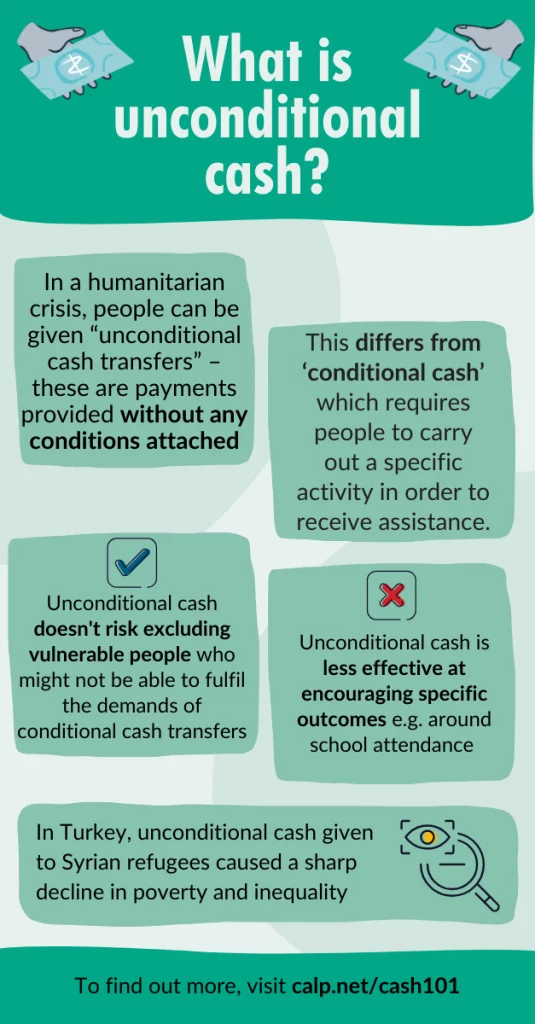Unconditional Cash Transfers

What is an Unconditional Cash Transfer?
In the context of humanitarian Cash and Voucher Assistance, unconditional cash transfers are payments provided to people affected by a crisis, without any associated conditions or requirements. Who receives them will depend on a programme’s ‘targeting criteria’ – such as, if an individual or household is internally displaced.
Unconditional cash transfers differ from conditional cash transfers, which require people to carry out a particular activity in order to receive payments. They give people affected by crises greater flexibility and is arguably the most dignified type of assistance.
Unconditional cash transfers are becoming an increasingly popular option for humanitarian agencies.
As with any form of CVA, the context needs to be appropriate for their use. For example, there should be functioning markets and services, acceptance by local stakeholders, and more. For more guidance on how and when to use CVA, see CALP’s Programme Quality Toolbox.

What is the difference between Unconditional and Conditional Cash Transfers?
With an unconditional cash transfer, the people targeted by the response do not have to comply with any requirements to receive payments. On the other hand, conditional cash transfers come with requirements attached, such as the need to carry out an activity or attend a healthcare centre.
Find out more on our Conditional Cash Transfers page.
Are unconditional cash transfers effective?
Unconditional cash transfers can be effective at improving the health and food security of people affected by crises, as well as offering better value for money than other types of aid.
For example, a multi-purpose cash transfer programme for displaced people and host communities in Uganda showed that unconditional cash transfers can deliver high value for money, with €0.61 or each €1 of the project reaching recipients. Settlements that covered more households and transferred more cash in total were the most cost-efficient.
In humanitarian crises with chronic food insecurity and among conflict-affected populations, unconditional cash transfers were found to be more effective at increasing food expenditure compared to those in a control group.
They can be used alongside other sector-specific interventions to improve their effectiveness. Studies of Cash Plus or integrated programming – which combine cash transfers with other services and interventions, – have been shown to result in positive impacts on early childhood health and nutrition.
To understand the wider benefits of cash and voucher assistance, visit our Benefits of CVA page.
The pros and cons of unconditional cash transfers
Pros:
- Better at meeting emergency needs: They tend to be more common in humanitarian assistance as they are more flexible and dignified, and are better at meeting urgent basic needs.
- Reduced barriers to aid: Placing conditions on cash transfers can exclude more vulnerable people, as it adds barriers to aid.*
- Can offer better value for money: They have lower administrative costs than other types of humanitarian assistance. If the priority is to reach as many people as possible, then unconditional cash enables the money to go further in terms of coverage.
- Easier to link with social protection systems: Linking humanitarian aid with social protection systems can help communities build longer-term resilience and recover more quickly from crises.
- Can benefit wellbeing: They are more likely to reduce how often displaced families skip meals or medical treatment due to lack of money and can reduce malnutrition in children.
Cons:
- Cannot be used if markets are failing: Like other forms of CVA, unconditional cash transfers might not be an appropriate response if people can’t buy what they need because markets are not functioning or services are not available.
- Less suited to encouraging specific outcomes: If a project has specific goals, it might be appropriate to tie payments to an activity. For example, conditional cash transfers can be more effective at encouraging school enrolments for girls or dietary diversity for children in humanitarian crises.
To find out more, visit the Types of CVA page, or take CALP’s CVA Fundamentals course.